Dinosaurs were giant, toothy reptilian creatures that wandered the Earth for millions of years, constantly searching for food and defending their territories. They roamed the world during the Mesozoic, a geological period from 252 million to 66 million years ago.
But what lived before the dinosaurs? Surprisingly, Earth’s creatures were highly diverse during the Carboniferous and Permian Eras (the time before dinosaurs) and also enormous. Unearth the nine massive prehistoric animals that lived before dinosaurs.
Scutosaurus
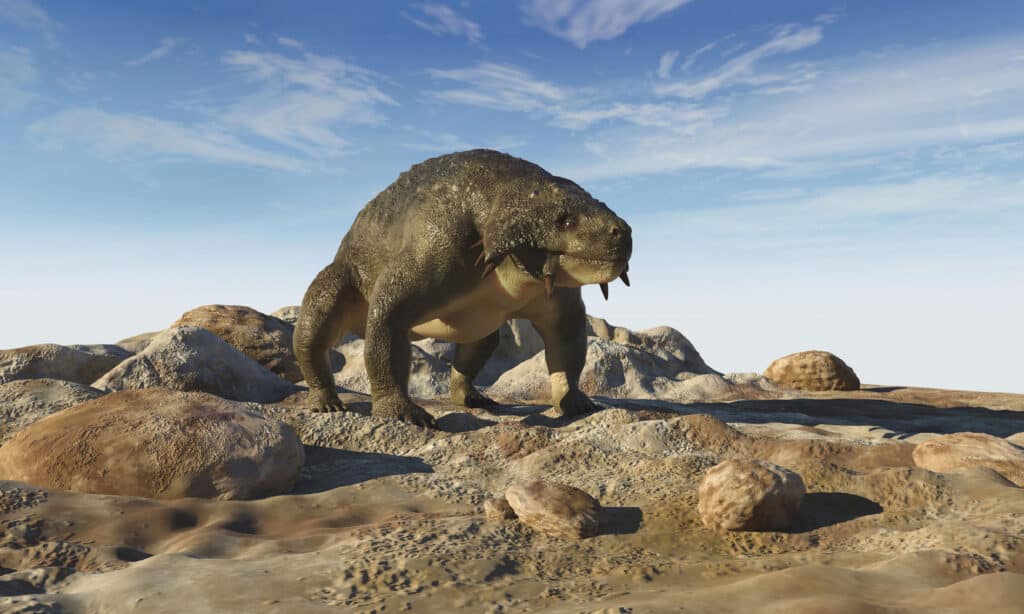
The Scutosaurus had a ten-foot armor-plated body.
©iStock.com/estt
The shield lizard, or the Scutosaurus, arose towards the end of the Carboniferous period, around 298 million years ago. It was among the largest reptiles during the Permian Era, featuring a 20-inch spiked skull and an armor-plated body that could grow over ten feet.
This terrestrial creature was hulking and intimidating, but research suggests it was a slow, heavy-footed herbivore that would have walked miles through its desert habitat looking for vegetation. Its meandering ways made it vulnerable to predators, like the Gorgonopsids.
Pterygotus
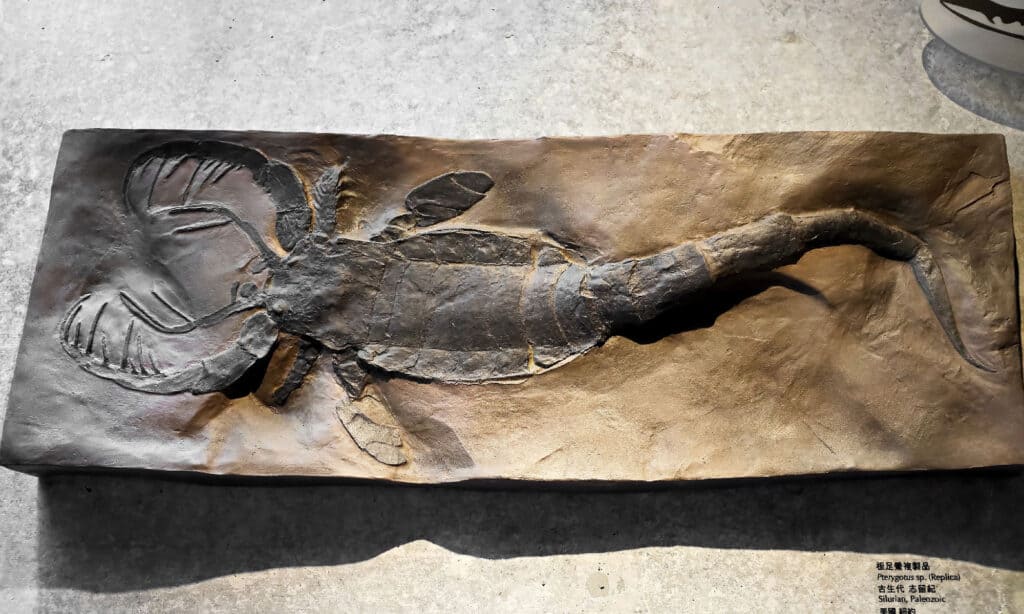
The Pterygotus was a giant sea scorpion that reached over six feet in length.
©topimages/Shutterstock.com
The giant sea scorpion was an enormous predatory aquatic arthropod. This ancient scorpion reached almost six feet, the size of a modern human, and lived on Earth’s oceans, hunting other creatures, like fish. Instead of a stinger, it had behemoth claws and would wait in ambush for its prey using its visual acuity. Then, it would grasp and puncture them with its pincer-like appendages.
Quarry men found the first fossil in early Devonian deposits in Scotland and Western England. While some of its features are recognizable in modern sea creatures, there are no present-day sea scorpions.
Dimetrodon Angelensis

The Dimetrodon had elongated spines extending from its vertebrae.
©Dziurek/Shutterstock.com
The Dimetrodon lived during the early Permian Period, and while it looks reptilian, it’s not related to dinosaurs. It’s more closely related to mammals, although not technically mammalian; it’s in the Sphenacodontidae family, a group of advanced carnivores.
Its most prominent feature is its sizeable neural spine sail, elongated spines extending from its vertebrate. It also walked on four legs, had a curved skull, and significantly-sized teeth. Researchers found its fossils in the southwestern United States in the Red Beds of Oklahoma and Texas.
Arthropleura
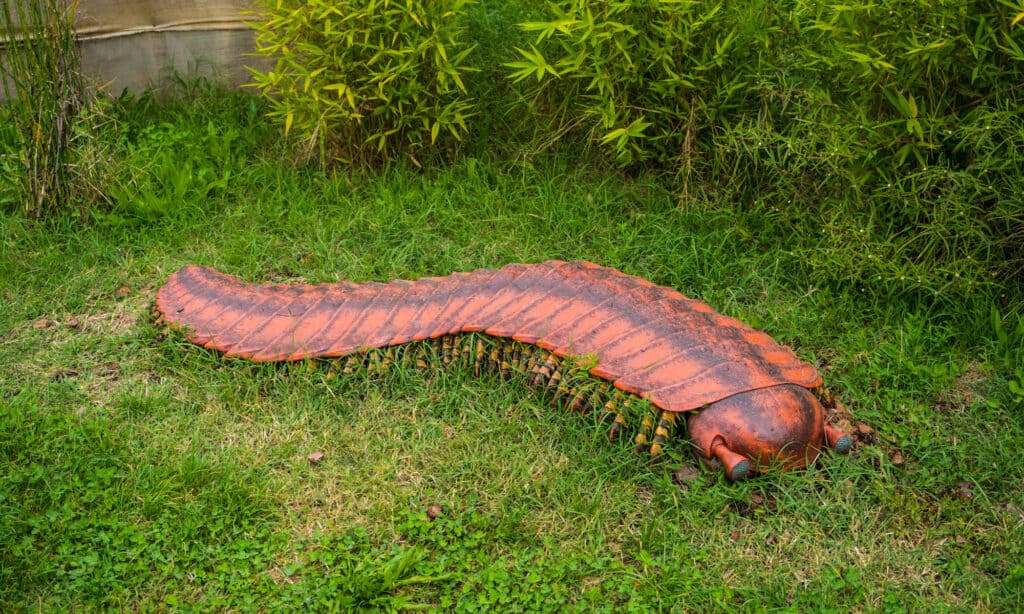
Gigantic millipedes crawled around the massive forests 345 million years ago.
©FABRIZIO CONTE/Shutterstock.com
Three hundred forty-five million years ago, gigantic millipede arthropods roamed the massive forests in North America and Europe. They were the most significant land invertebrates ever to exist and wouldn’t have had many predators. Arthropleures grew to well over seven feet and could stand upright and spray acid at any perceived threat.
Despite their fearsome features, these millipedes were some of the first plant-eaters, and they used their powerful jaws to break down tough vegetative matter instead of using them to eat animals. Arthropleures became extinct due to the desiccation of the equator and the diversification of vertebrate animals.
Gorgonopsids
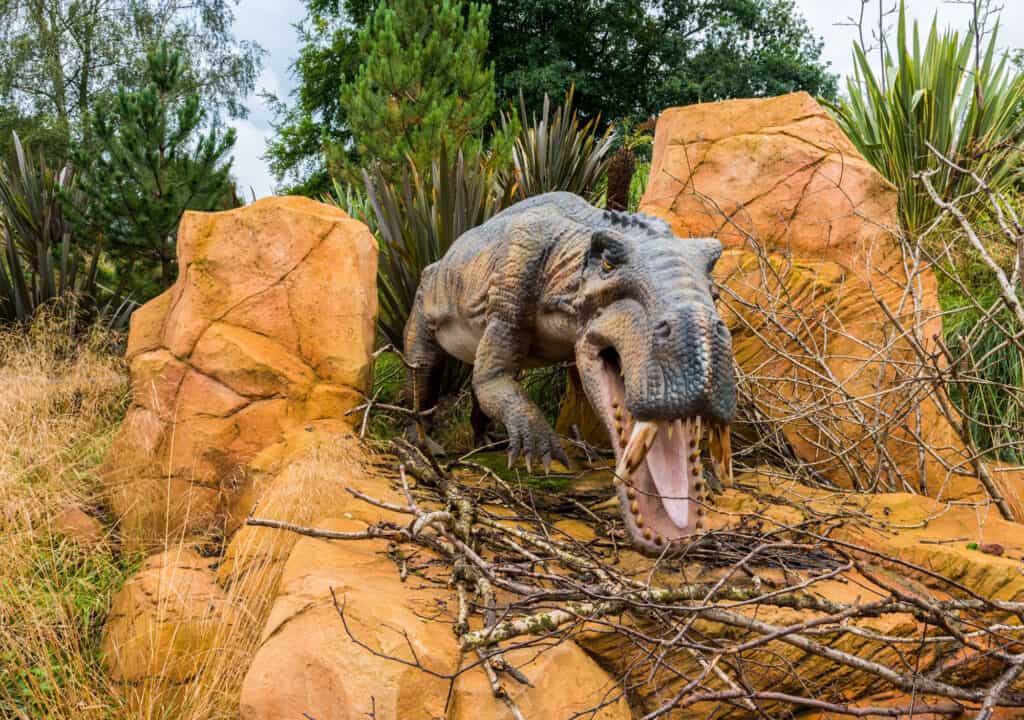
The Gorgonopsid was a saber-toothed mammal the size of a bear.
©Jeremy Alan Baxter/Shutterstock.com
Named after the Greek mythological beast, Gorgonopsids are an extinct group of saber-toothed mammals from the Middle-Upper Permian Era. They had narrow skulls and elongated teeth, which they used to slash and stab prey and predators.
They were vicious hunters, taking chunks out of their target and retreating until it weakened enough for them to give a killing bite. This species may have begun relatively small but evolved to a bear-like size, where they likely became apex predators in areas of Tanzania, Zambia, and Malawi.
Jaekelopterus
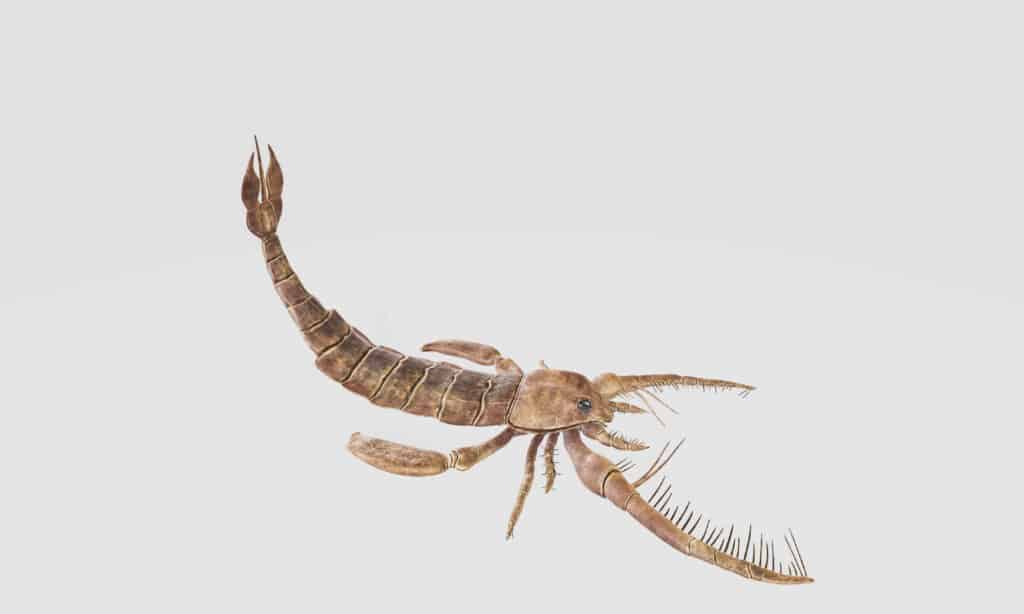
The Jaekelopterus was the largest arthropod ever to exist.
©Adiss Alic/Shutterstock.com
The Jaekelopterus was another giant scorpion living during the Devonian Period 390 million years ago. It was the biggest arthropod ever to inhabit the Earth and the largest of its species, growing over eight feet long. Instead of swimming in the ocean, this scorpion developed in freshwater systems like river beds.
It was an apex predator in its aquatic environment, preying on smaller arthropods and early vertebrates. Research suggests it chased its prey in lagoons and estuaries with a high level of maneuverability and agility.
Meganeura
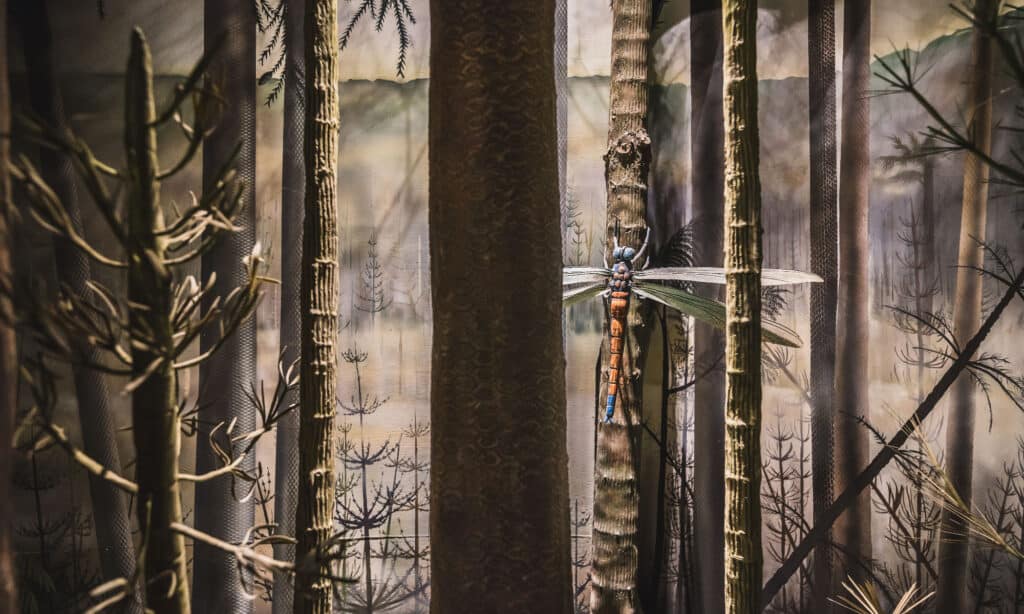
The Meganeura was a giant flying insect similar to a dragonfly.
©Marbury/Shutterstock.com
The Meganeura was the largest flying insect in existence, resembling a modern-day dragonfly, except much more considerable. It inhabited the carboniferous forests alongside the Arthropleura and was predatory, mainly consuming other insects. Its wingspan reached 25.6 inches feet, and its larva was at least 12 inches long. It spent much of its time in the air, buzzing around and looking for spiders and small amphibians. Scientists first discovered its fossil in France in 1880.
Titanichthys

The Titanichthys was 33 feet long and had an armored body.
©Entelognathus / CC BY-SA 4.0 – License
The Titanichthys was a giant-armored fish from the late Devonian Period. It lived in the shallow seas of Morocco, Eastern North America, and Europe. Scientists believe this enormous fish was the first large-sized vertebrate filter feeder, using its mouth to inhale anchovy-like fish. This fish could reach a length of 16 feet and featured an insanely-big mouth and blunt teeth.
Aegirocassis
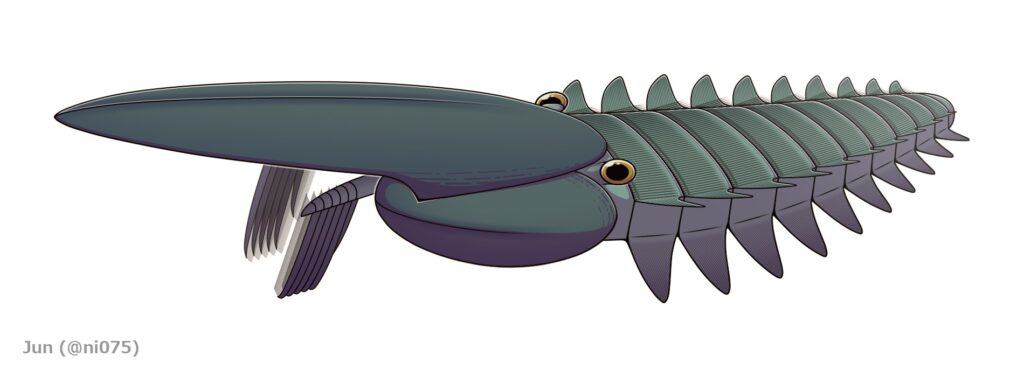
The Aegirocassis was the earliest filter feeder and resembled a massive prawn.
©Junnn11 / CC BY-SA 4.0 – License
This prehistoric creature was a stem-group arthropod from the early Ordovician Era, 480 million years ago. It was the largest animal to exist in this era and the earliest giant filter feeder. This arthropod most closely resembled a massive prawn; it reached seven feet long and featured swimming flaps and a filtering mesh that would have helped guide food into its soft mouth parts.
It was a remarkable-looking creature that lived in the ocean near southeastern Morocco. It would have inhabited a shallow sea that covered what is today the Sahara Desert. This species died out at the end of the Cambrian Era. What began as an evolutionary success turned to total extinction.
When Was the Carboniferous Period?
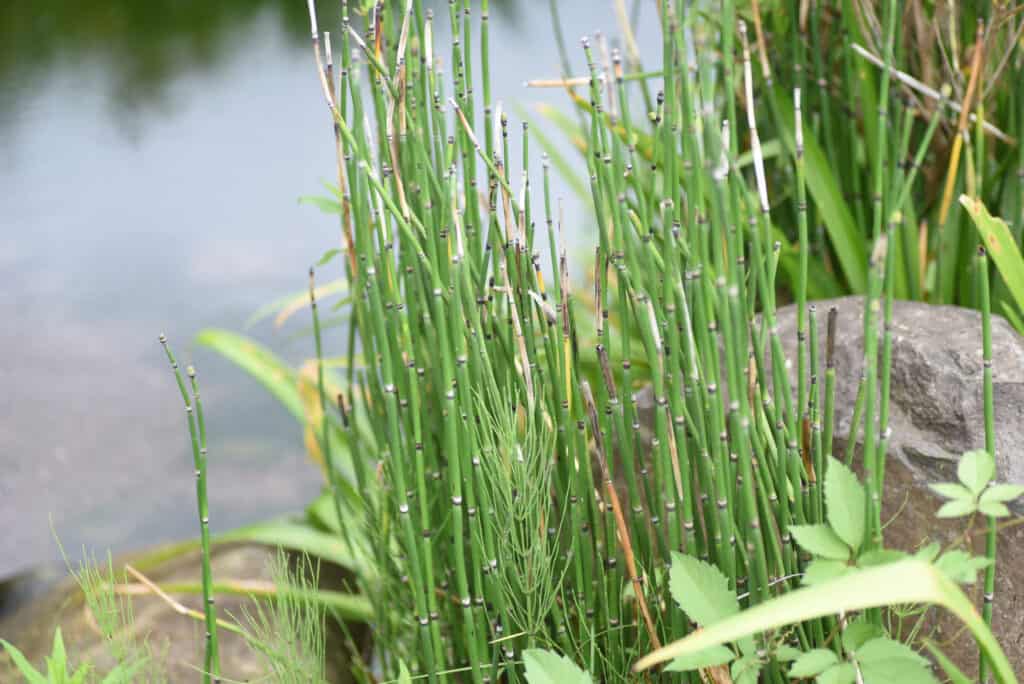
Horsetails during the Carboniferous period were up to 100 feet tall.
©iStock.com/undefined undefined
The Carboniferous Period was from 354 to 290 million years ago. During this time, hot and humid conditions covered the northern landmass of Laurussia, while the southern lands were much colder. In the plant kingdom, large club mosses, tree ferns, and horsetails grew in swamps and estuaries, along with seed-bearing plants. They were up to 100 feet tall!
The insect population was also quite varied, with millipedes, dragonflies, and other bugs. Some of the flying insects had wingspans of up to two feet wide! Reptiles evolved as the first land-dwelling animals around the middle of the period, and sharks and bony fishes replaced the jawless agnathans and armored placoderms in the seas. Marine invertebrates like starfish, gastropods, and sea urchins flourished on the recovering reefs.
What Happened at the End of the Carboniferous Period?
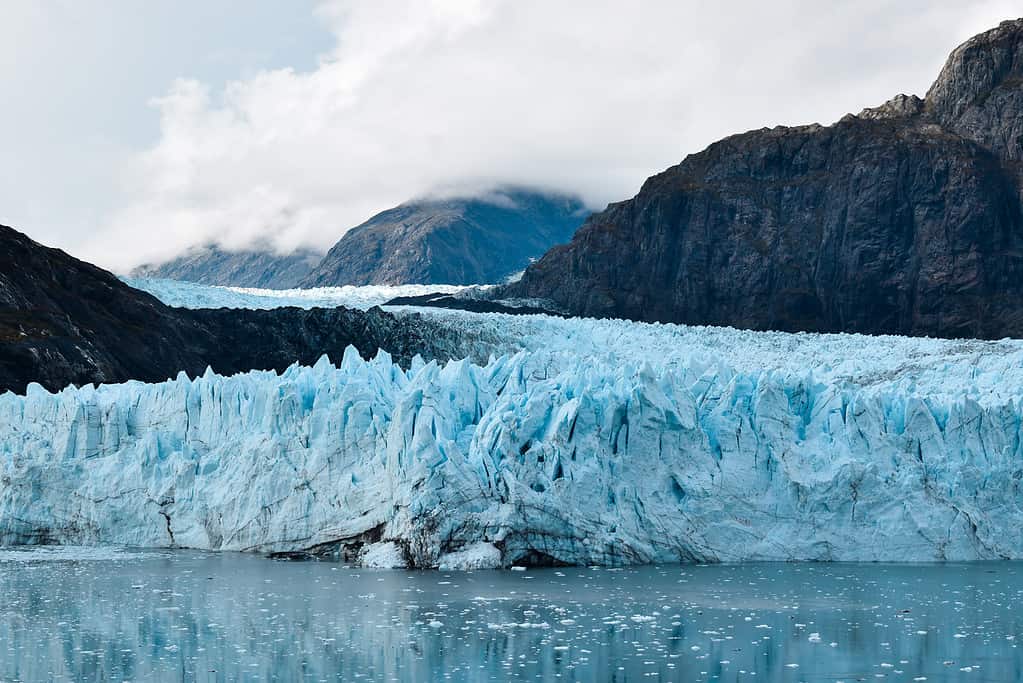
During the very last part of the Carboniferous period the weather got so cold that glaciers formed.
©Georgina Burrows/iStock/Getty Images via Getty Images
At the end of the Carboniferous Period, approximately 350 million years ago (mya), coal forests began to form in wetlands at the edges of continents. The submerged plant matter did not decompose completely and ended up being buried, eventually transforming into coal due to heat and pressure.
At this same time, early reptiles with similar skeletal features to those of amphibians emerged, though there were some differences in their skulls and vertebrae that signified their relationship to later reptiles such as turtles and dinosaurs.
Then, glaciations, a decrease in sea levels, and the formation of Pangaea due to the continents joining together took place. A minor extinction event of both marine and land life, known as the Carboniferous rainforest collapse, happened at the end of the period due to climate change.
Summary of 9 Massive Prehistoric Animals That Lived Before Dinosaurs
Here is a summary of some of the animals that lived before dinosaurs:
| Species | Characteristics | When did it live? |
|---|---|---|
| Scutosaurus | Had a 20-inch spiked skull and an armor-plated body. Hulking and slow-moving | Carboniferous period |
| Pterygotus | Six-foot-long sea scorpion that would grasp prey with its claws and kill them with pincer-like appendages. | Devonian period |
| Dimetrodon Angelensis | An advanced carnivore that was not quite reptilian or mammalian. Possessed a large neural spine sail and giant teeth. | Permian period |
| Arthropleura | Giant millipedes that could grow up to seven feet in length. Could spit acid, though this was usually used for digesting plant matter. | 345 million years ago |
| Gorgonopsids | A saber-toothed apex predator that hunted with vicious tactics. | Middle-Upper Permian era |
| Jaekelopterus | A freshwater scorpion that could grow up to eight feet in length. It possessed a high degree of agility. | Devonian period |
| Meganeura | A giant relative of the modern-day dragonfly; preyed upon spiders and small amphibians. | 345 million years ago |
| Titanichthys | An armored fish that is believed to have been the first filter-feeding vertebrate. | Late Devonian period |
| Aegirocassis | The earliest giant filter feeder; it could grow up to seven feet in length and resembled a giant prawn. | Early Ordovician era |
The photo featured at the top of this post is © Daniel Eskridge/Shutterstock.com
Thank you for reading! Have some feedback for us? Contact the AZ Animals editorial team.






